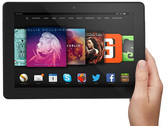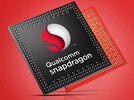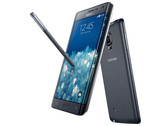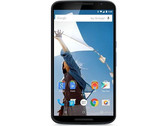
Amazon Fire HDX 8.9 (2014) Tablet Review
Qualcomm Snapdragon 805 APQ8084 | Qualcomm Adreno 420 | 8.90" | 375 g

The Qualcomm Snapdragon 805 (APQ8084) is an ARM-based SoC largely for Android tablets and smartphones. Announced in November 2013, the S805 is the successor to the Snapdragon 801, making it the new top model among the ARM SoCs from Qualcomm. In addition to the slightly improved quad-core CPU (2.7 GHz vs. 2.5 GHz S801), the SoC integrates a brand-new GPU. The Adreno 420 offers new features like DirectX 11 and outperforms its predecessor by up to 40 percent. Furthermore, the chip integrates a 128-bit memory controller (LPDDR3-1600, 25.6 GB/s) and supports both Wi-Fi (802.11a/b/g/n/ac) and Bluetooth 4.1. UMTS and LTE(+) can be added by an additional radio (e.g. Gobi MDM 9x35).
CPU
The CPU cores have been modified just slightly and are now based on the Krait 450 architecture (performance per clock between Cortex-A7/A9 and Cortex-A15 or Apple Cyclone). This also means that the cores are still based on the ARMv7 ISA, which is a 32-bit design. Competitors like Apple are already selling 64-bit-capable ARMv8 chips, e.g. the Apple A8 and A8X as found on the iPhone 6 and iPad Air 2. Thanks to its quad-core design and very high clock rates of up to 2.7 GHz, the Snapdragon 805 offers a performance similar to the Samsung Exynos 5433 and is therefore one of the fastest ARM-based SoCs of 2014.
GPU
The new Adreno 420 graphics unit not only supports DirectX 11.1 (and therefore new features such as tessellation), but will also provide an up to 40 percent 3D performance boost compared to the previous Adreno 330. Overall, the Adreno 420 (usually clocked at 600 MHz) is somewhat faster than the Mali-T628 MP6 (Samsung Exynos 5420/5430) and PowerVR G6430 (Apple A7). Only Nvidia's Tegra K1 and the PowerVR GX6650 (Apple A8X) are offering an even higher performance.
Features
As the Snapdragon 805 does not have a cellular modem, an additional module must be installed for use in smartphones. Qualcomm provides either the Gobi MDM9x25 or MDM9x35 series, both of which include support for UMTS, LTE(+) Cat. 4 and carrier aggregation.
The Snapdragon 805 is one of the first SoCs available to be able to decode 4k videos with the H.265 codec and stream the content to a compatible TV. A large number of older video codecs are also supported.
The revised camera ISP is now even more powerful than before and can handle a throughput in the GPixel/s range. This allows advanced post-processing capabilities as well as cameras with higher resolutions.
Power Consumption
The Snapdragon 805 is manufactured by TSMC in a 28-nanometer HPM process. The power consumption should be approximately in the range of its predecessor, which we have estimated at about 3 - 5 W. The full performance will only be achieved in larger tablets as they can tolerate higher temperatures generally better than smaller smartphones.
| Codename | Krait 450 |
| Series | Qualcomm Snapdragon |
| Clock Rate | 2700 MHz |
| Level 1 Cache | 0 MB |
| Level 2 Cache | 2 MB |
| Number of Cores / Threads | 4 / 4 |
| Manufacturing Technology | 28 nm |
| Features | Adreno 420 GPU, WLAN 802.11a/b/g/n/ac (2.4/5 GHz), Bluetooth 4.1, 128 Bit LPDDR3-1600 Memory Controller (25.6 GB/s) |
| GPU | Qualcomm Adreno 420 (600 MHz) |
| Architecture | ARM |
| Announcement Date | 11/20/2013 |
| Product Link (external) | www.qualcomm.com |




Motorola Droid Turbo: Qualcomm Adreno 420, 5.20", 0.2 kg
External Review » Motorola Droid Turbo
Amazon Fire HDX 8.9 inch 2014: Qualcomm Adreno 420, 8.90", 0.4 kg
External Review » Amazon Fire HDX 8.9 inch 2014
Google Nexus 6: Qualcomm Adreno 420, 6.00", 0.2 kg
External Review » Google Nexus 6
Samsung Galaxy Note Edge: Qualcomm Adreno 420, 5.60", 0.2 kg
External Review » Samsung Galaxy Note Edge
Samsung Galaxy Note 4: Qualcomm Adreno 420, 5.70", 0.2 kg
External Review » Samsung Galaxy Note 4
Samsung Galaxy S5 LTE-A Prime: Qualcomm Adreno 420, 5.10", 0.1 kg
External Review » Samsung Galaxy S5 LTE-A Prime
» Mobile CPU Comparison
Comparison of all mobile CPU series
» Mobile Processors - Benchmarklist
Benchmarklist of all known CPUs that are used in laptops (desktop and laptop CPUs)
Top 10 Laptops
Multimedia, Budget Multimedia, Gaming, Budget Gaming, Lightweight Gaming, Business, Budget Office, Workstation, Subnotebooks, Ultrabooks, Chromebooks
under 300 USD/Euros, under 500 USD/Euros, 1,000 USD/Euros, for University Students, Best Displays
Top 10 Smartphones
Smartphones, Phablets, ≤6-inch, Camera Smartphones